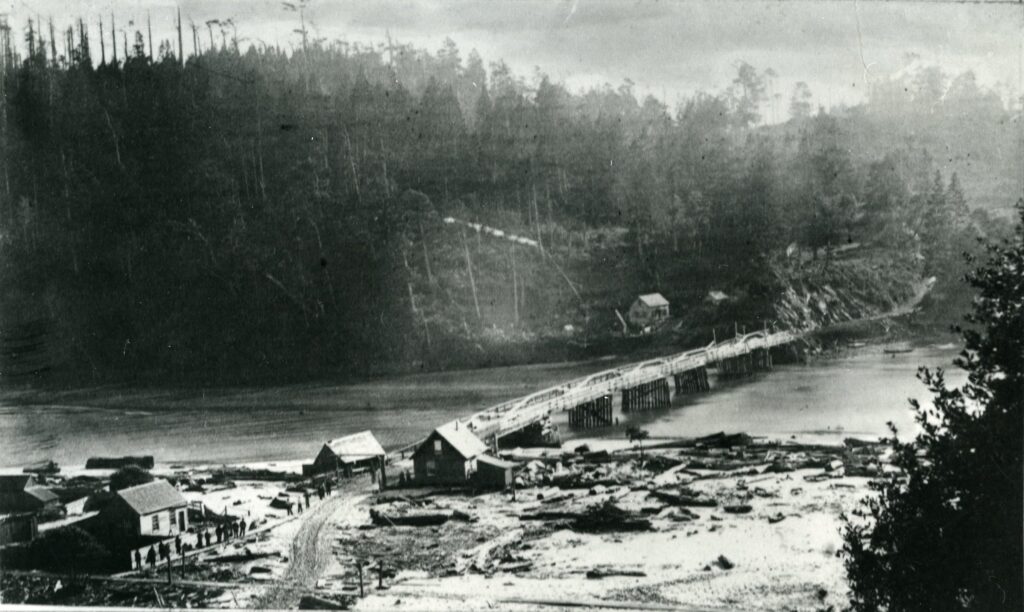
BIG RIVER BRIDGE – built in 1861 as a toll bridge, this span replaced the ferry operated by P. S. Palmstream. It became a free bridge in 1878 when the people voted to raise their taxes and buy it so they did not have to pay to cross it. Tolls at that time: Wagon and six animals, 50 cents; with four, 30 cents; with two, 25 cents; with one 15 cents; horsemen, 15 cents; pack animals, per head, 10 cents; loose horse and cattle, 3 cents; hogs and sheep, 2 cents. It was replaced in 1882 by another bridge. The present bridge over Big River was officially opened in November of 1961.
Seventy-five years ago, on October 13, 1947, a public hearing was held at the high school to consider building a new bridge over Big River. The mill had been dismantled, and the estuary and river were beginning to recover some pristine beauty. The existing truss bridge, more than twenty years old, was inadequate and failing. A modern structure had to be erected. That was not surprising; building and replacing bridges on the coast had been an ongoing concern since the earliest times.
Initially, flatboat-ferries crossed the wider creeks and rivers. They were replaced by timber bridges and even draw bridges. Crossings were private operations – not funded by the state or county – so the builders charged tolls. Floods, earthquakes, storms and slides also took their toll; delays were numerous. Mail delivery could be cut off for up to a week.
In 1933, when the State Highway System took over maintenance of the coast road, there were eighty timber bridges on the 82-mile stretch from Gualala to Westport. Twenty-two were between Navarro and Fort Bragg; most were posted for five to eleven tons burden.
By 1957 – twenty-four years later – ten remained. Today, one wooden bridge remains: the Albion bridge, built in 1944 to replace the old one, which was closed to trucks when severe sagging of the spans developed.
Most early bridges were cross-planked with wood. Then improvements began to smooth the way. As reported in The Beacon on August 24, 1918, “Roadmaster John Chambers is re-planking Jack Peters Gulch Bridge this week. The planks [now] will be laid parallel to the line of travel, which cuts down vibration to a minimum … and makes traveling a pleasure over structures thus planked.”
Today, we swish over stretches of Highway One unaware what lies beneath the road surface. Few recall when Gordon’s and Brewery Gulch, Buckhorn, Barton and Dark Gulch would give motorists fits. By the mid-twentieth century, innumerable curves were removed; gone were steep grades down ravines, across creeks and up again. At Salmon Creek, a vivid reminder of that hair-raising trek remains. Today, If it weren’t for the concrete sides and railings, a motorist might miss the bridge at Little River.
Six million dollars were spent over time to replace seventy old structures, and high bridges became commonplace. In our neck of the woods are Salmon Creek, Albion River, Big River, Jack Peters, Caspar Creek, Hare Creek and Noyo River.
Shenanigans amuse us, whether political or otherwise. In mid- October 1947, the Big River bridge issue was whether to build a high bridge, 60 feet above mean high water, or a low one at 35 feet. The old bridge was 16 feet high. The War Department (Army and Navy) was considering harboring war vessels in the bay and upriver. This meant a higher bridge and included dredging the riverbed some distance upstream. Considered, too, was dredging Mendocino Bay to provide safe mooring for warships. This appealed to the Navy.
Fishing became a “red-herring” to muddy the waters (and muddle the metaphor). Fort Bragg interests opposed the project, concerned that Federal money would be siphoned away from Noyo: funds for dredging and maintenance of their fishing, harbor and riverine economy. Fort Bragg sent vocal locals to scuttle construction of the bridge. By advocating the higher bridge, to provide clearance for salmon fishing boats with tall masts, they helped carry the day.
The state had insufficient funds to build a high bridge, withdrew its application, and no new bridge was built over Big River until November1961 – fourteen years later. While high enough above the river, nary a commercial fishing boat ever passed under it.